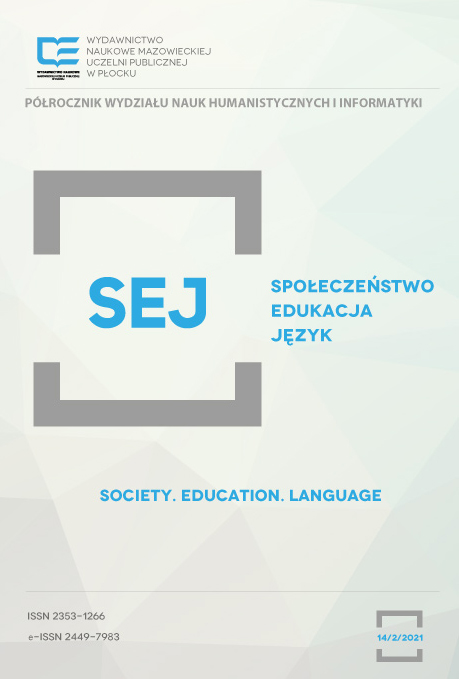DIAGNOSIS OF PRESCHOOLERS’ RECOGNITION OF GEOMETRIC SHAPES
DOI:
https://doi.org/10.19251/sej/2021.14.2(9)Keywords:
child, kindergarten, diagnosis, geometric skillsAbstract
The article presents the results of research aimed at diagnosing flat geometric figures by children aged 5-7 who attended selected kindergartens in the Biała Podlaska poviat. 354 children were included in the research. Modern technologies were used for diagnosis, such as a stationary Eye Tracker Glasses, which records data with a measurement frequency of 250 Hz. This modern tool has a special measurement system that tracks and records the image, in what order and at what pace the examined person looks. The Pearson Chi-square test was used to demonstrate the differences between the correctness of the tasks performed and the kindergarten attended by the examined child. One-way analysis of variance was used to assess the differences in the performance of the task. In all analysed cases, the level of significance was p = 0.05. The results of the studied group of pre-schoolers showed differences in the level of knowledge and skills in geometry. An important factor influencing this level is the age at which preschool education begins and its duration.
References
Dąbrowski, Mirosław. 2015. O umiejętnościach matematycznych trzecioklasistów –
subiektywny wybór z badań. Studia Pedagogiczne, LXVIII, s. 289-30.
Fayol, Michel i Xavier Seron. 2005. About Numerical Representations Insights from
Neuropsychological, Experimental, and Developmental Studies.W: Handbook of Mathematical Cognition, red. Jamie I.D. Campbell. New York: Psychology Press. DOI: https://doi.org/10.4324/9780203998045.
Frydrychowicz, Anna i Elżbieta Koźniewska i Andrzej Matuszewski i Elżbieta Zwierzyńska.
Skala gotowości szkolnej.Warszawa: Centrum Metodyczne Pomocy Psychologiczno-Pedagogicznej.
Ginsburg, Herbert i Joon Sun Lee i Judi Stevenson Boyd. 2008. Mathematics education for
young children: What it is and how to promote it. Social Policy Report. Society for Research In Child Development,Vol.22,No.1, s. 3-24.https://files.eric.ed.gov/fulltext/ ED521700.pdf.
Jordan, Nancy i David Kaplan i Chaitanya Ramineni i Maria C. Locuniak. 2009. Early math
matters: Kindergarten number competence and later mathematics outcomes. Developmental Psychology, 45(3), s. 850-867. DOI:10.1037/a0014939.
Klim-Klimaszewska, Anna i Stanisława Nazaruk. 2017.The scope of implementation of
geometric concepts in selected kindergartens in Poland. Problems of Education in the 21st Century,75(4), s.345-353.
Morgan, Paul i George Farkas i Qiong Wu. 2009. Five-year growth trajectories of
kindergarten children with learning difficulties in mathematics. Journal of Learning Disabilities,42(4), s. 306-321. http://dx.doi.org/10.1177/0022219408331037.
Oszwa, Urszula. 2006. Rozwój i ocena umiejętności matematycznych dzieci sześcioletnich.
Warszawa: Centrum Metodyczne Pomocy Psychologiczno-Pedagogicznej.
PISA. 2012. Wyniki badania 2012 w Polsce. http://www.ibe.edu.pl/images/prasa/PISA-2012-
raport _ krajowy.pdf.
PISA. 2015. Results Excellence and equity in education. Vol. I, OECD 2016.
http://www.oecd.org/education/pisa-2015-results-volume-i-9789264266490-en.htm.
Pregler, Anna i Ewa Wiatrak red. 2011. Ogólnopolskie badanie umiejętności trzecioklasistów.
Raport z badań OBUT 2011.Warszawa: Centralna Komisja Egzaminacyjna.
Sarama, Julie i Douglas Clements. 2004. Building Blocks for early childhood mathematics.
Early Childhood Research Quarterly, 19(1), s. 181-189. http://dx.doi.org/10.1016/j. ecresq.2004.01.014.
Sikder, Shykla i Marilyn Fleer. 2016.Incremental Science Learning in Toddler’s Play.
International Journal of Science Education, Part B.6(4), s.1-21.
Simanowski, Stefanie i Kristin Krajewski. 2019. Specific Preschool Executive Functions
Predict Unique Aspects of Mathematics Development: A 3-Year Longitudinal Study. Child Development, 90(2), s. 544–561. https://doi.org/10.1111/cdev.12909.
Załącznik nr 1 do Rozporządzenia Ministra Edukacji Narodowej z dnia 14 lutego 2017 r. w
sprawie podstawy programowej wychowania przedszkolnego oraz podstawy programowej kształcenia ogólnego dla szkoły podstawowej, w tym dla uczniów z niepełnosprawnością intelektualną w stopniu umiarkowanym lub znacznym, kształcenia ogólnego dla branżowej szkoły I stopnia, kształcenia ogólnego dla szkoły specjalnej przysposabiającej do pracy oraz kształcenia ogólnego dla szkoły policealnej (Dz.U.2017, poz.356).
